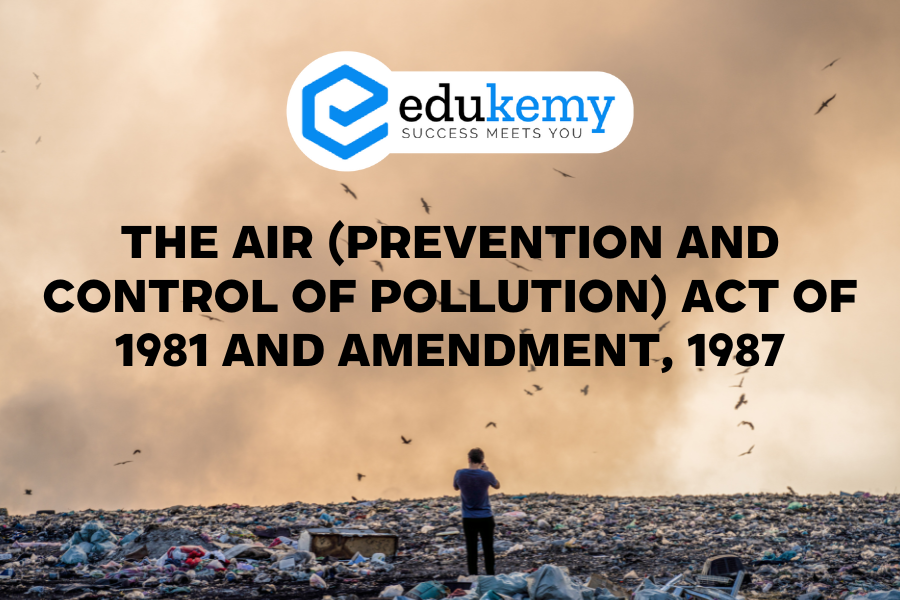The Air (Prevention and Control of Pollution) Act of 1981 stands as a pivotal legislation in India’s environmental framework, aimed at addressing the burgeoning issue of air pollution. Enacted to safeguard public health and the environment from the adverse effects of air pollution, this act provided a legal framework for the prevention, control, and abatement of air pollution. Recognizing the urgent need for stringent measures, the Act empowered authorities to set standards, regulate emissions, and establish control mechanisms. However, acknowledging the evolving nature of environmental challenges, the Act underwent significant amendment in 1987. This amendment bolstered the Act’s efficacy by incorporating provisions to tackle emerging pollutants and enhancing enforcement mechanisms. Together, the original Act and its subsequent amendment represent crucial milestones in India’s efforts to combat air pollution and promote environmental sustainability.
- The Nationwide Air Act was enacted by Parliament to operationalize the resolutions made at the United Nations Conference on the Human Environment in Stockholm in June 1972.
- The primary goals of this legislation are to enhance air quality and to address, manage, and reduce air pollution throughout the country.
Contents
- 1 FAQs Regarding the Air (Prevention and Control of Pollution) Act 1981 and its Amendment in 1987:
- 1.1 1. What is the purpose of the Air (Prevention and Control of Pollution) Act 1981?
- 1.2 2. What are the key definitions under the Air Act?
- 1.3 3. What role does the Central Pollution Control Board (CPCB) play under this Act?
- 1.4 4. Are there specific provisions regarding industries under this Act?
- 1.5 5. What powers do State Pollution Control Boards (SPCB) have under the Air Act?
- 2 In case you still have your doubts, contact us on 9811333901.
DEFINITIONS UNDER THIS ACT
- The Air (Prevention and Control of Pollution) Act outlines various definitions, including in Section 2(a) where ‘air pollutants’ are defined as solid, liquid, or gaseous substances capable of causing harm to the environment, humans, plants, animals, or property.
- An amendment in 1987 expanded this definition to include ‘noise’ as a harmful substance.
- Furthermore, the Act characterizes ‘air pollution’ in general as the presence of any hazardous pollutant that renders the air unfit for breathing.
- Section 2(g) of the Act establishes the Central Pollution Control Board (CPCB) with jurisdiction over the entire country.
- To implement CPCB’s directives, the Act mandates the establishment of State Pollution Control Boards (SPCB) for individual states in India.
IMPORTANT PROVISIONS UNDER THIS ACT
Key provisions of the Air (Prevention and Control of Pollution) Act include:
- The Air Act shares a structural similarity with the 1974 Water Act, expanding the authority of central and state boards established under the Water Act to encompass air pollution control.
- States lacking water pollution boards were mandated to establish air pollution boards.
- Industries operating within specified air pollution control areas under the Air Act must obtain “consent” (permit) from the State Boards.
- States are obligated to establish emission standards for industry and automobiles in consultation with the central board, considering its ambient air quality standards.
- The Act empowers State Pollution Control Boards (SPCB) to test equipment and collect samples for analysis from chimneys, fly ash, dust, or other sources.
- Before the 1988 amendment, enforcement involved criminal prosecutions initiated by the Boards.
- The 1988 amendment granted SPCB and CPCB the authority to shut down a non-compliant industrial plant.
- The 1987 amendment introduced a citizen’s suit provision into the Air Act and expanded its scope to include noise pollution.
PENALTIES UNDER THIS ACT
- Failure to adhere to the directives of the Central Pollution Control Board may lead to imprisonment for up to one year.
- This imprisonment term can be extended to six years, accompanied by a fine.
- Additionally, an extra fine of Rs 5000 per day may be imposed if the directives remain unfulfilled.
FAQs Regarding the Air (Prevention and Control of Pollution) Act 1981 and its Amendment in 1987:
1. What is the purpose of the Air (Prevention and Control of Pollution) Act 1981?
A: The Act was enacted to implement resolutions from the United Nations Conference on the Human Environment in 1972. Its primary objectives are to enhance air quality and address, manage, and reduce air pollution across the nation.
2. What are the key definitions under the Air Act?
A: Section 2(a) defines ‘air pollutants’ as solid, liquid, or gaseous substances harmful to the environment, humans, plants, animals, or property. An amendment in 1987 added ‘noise’ to this definition. ‘Air pollution’ is broadly defined as the presence of any hazardous pollutant making the air unfit for breathing.
3. What role does the Central Pollution Control Board (CPCB) play under this Act?
A: Section 2(g) establishes the CPCB with jurisdiction over the entire country. The Act mandates the creation of State Pollution Control Boards (SPCB) to implement CPCB’s directives at the state level.
4. Are there specific provisions regarding industries under this Act?
A: Yes, industries operating within designated air pollution control areas must obtain a “consent” (permit) from State Boards. Emission standards for industries and automobiles are set by the states after consulting the central board and considering ambient air quality standards.
5. What powers do State Pollution Control Boards (SPCB) have under the Air Act?
A: SPCBs have the authority to test equipment and collect samples for analysis from sources such as chimneys, fly ash, dust, or other emissions.
In case you still have your doubts, contact us on 9811333901.
For UPSC Prelims Resources, Click here
For Daily Updates and Study Material:
Join our Telegram Channel – Edukemy for IAS
- 1. Learn through Videos – here
- 2. Be Exam Ready by Practicing Daily MCQs – here
- 3. Daily Newsletter – Get all your Current Affairs Covered – here
- 4. Mains Answer Writing Practice – here

